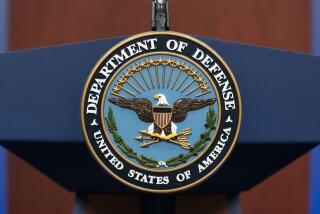Marine Command Formed From Mishmash of Units
- Share via
With up to 30,000 of its Marines deployed to Persian Gulf War, Camp Pendleton is taking the left-behind pieces of units and creating a major command to respond to any potential trouble spots in the Pacific.
The V Marine Expeditionary Force will contain ground, air and logistic strength for combat operations. It also will be responsible for training replacements for Marines now in the Middle East.
Its troop size hasn’t been determined yet, and Maj. Laurel Hull, adjutant of the V Marine Expeditionary Force, said, “It’s still forming, it’s still at sort of a liquid stage.”
The outfit was first organized to fight in the Pacific during World War II and was called back to service for short periods in the 1960s, but had been deactivated for years.
“The history of V MEF is rather skimpy,” Hull said. “It’s faded in and out” over the years.
But, with the huge deployment of Marines to oppose Iraq’s invasion of Kuwait, the need for an additional expeditionary force prompted Marine Corps Commandant Al Gray to reactivate the V MEF in January.
“It’s part of our preparedness. There’s the rest of the world still out there,” said Maj. Rick DeChaineau, a spokesman at Headquarters Marine Corps in Washington.
The number of Marines stationed in the United States was dramatically depleted to build a fighting force in the Middle East. “We’re not discussing numbers,” said Capt. Rose-Ann Sgrignoli, a spokeswoman for Camp Pendleton.
However, other military sources indicate that up to 30,000 Marines, including reservists called back to active duty, have been deployed from Camp Pendleton. They are part of the 80,000 Marines serving in Gulf region.
Most of the 1st Marine Expeditionary Force from Camp Pendleton shipped out last August, followed by the 5th Marine Expeditionary Brigade in December.
An expeditionary force is made up of about 35,000 Marines, including ground, air, supply and command elements.
The Marine contingents from Camp Pendleton were beefed up with units from Twentynine Palms in San Bernardino County and aircraft from the Marine Corps Air Stations at El Toro in Orange County. Parts of the deployed units have stayed behind and now are being forged into the V MEF.
Organizing an expeditionary force for a specific task is “the Marine Corps’ bread and butter,” DeChaineau said.
Specifically, the V MEF is being made up of remnants of the 1st Marine Division from Camp Pendleton, the 3rd Marine Air Wing from El Toro, and the 1st Force Service Support Group from Camp Pendleton.
“We are using as the basis the remnants of what was left in the rear when the 1st Marine Expeditionary Force went away,” Hull said. “We took the rears and compiled them into V MEF.”
Also, it is being bolstered with Marines coming from reserve combat units from New York, New Jersey, Pennsylvania, Texas, Louisiana, Alabama, Illinois, Montana and Maryland.
The reactived expeditionary force is commanded by Brig. Gen. Harold W. Blot, and its mission will be varied.
“We could be used anywhere in the Pacific,” Hull said. But the V MEF also will be available to reinforce Marine units in the Gulf War and to train replacements.
“We’re in preparation to reinforce if necessary, but mostly to replace” with newly trained troops, Hull said. In addition, it will maintain equipment the deployed units left on base.
The V MEF’s precise assignments and organization are still being discussed and shaped by senior Marine officers, Hull said.
More to Read
Sign up for Essential California
The most important California stories and recommendations in your inbox every morning.
You may occasionally receive promotional content from the Los Angeles Times.










